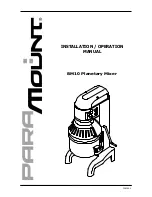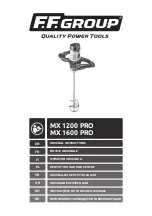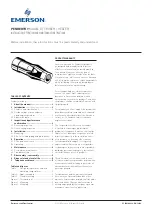
13
Owner’s Manual
Owner’
s Manual
Use these jacks for convenient playback of mixes.
You’ll be able to review a mix, and then rewind and try
another pass without repatching or disturbing the mixer
levels. You can also use these jacks with a CD player
to feed music to a PA system between sets.
WARNING:
Pushing tape to main mix [41]
in the output section can create a feedback
path between tape input and tape output.
Make sure your tape deck is not in record, record-pause
or input monitor mode when you engage this switch,
or make sure the tape in level knob is fully counter-
clockwise (off).
13. Main Insert
These 1/4" jacks are for connecting serial effects such
as compressors, equalizers, de-essers, or filters. The
insert point is after the mix amps, but before the main
mix [37] fader. Insert cables must be wired thusly:
Tip = send (output to effects device)
Ring =
return (input from effects device)
Sleeve =
common ground
14. Main Outs
These 1/4" jacks are usually patched to the inputs
of your 2-track mixdown deck (unless you’ve chosen
to use the tape output [11] RCA jacks), or to the house
amplifier during live sound sessions. To learn how
signals are routed to these outputs see main mix [37]
fader details on page 19. To use these outputs to drive
balanced inputs, connect 1/4" TRS (Tip-Ring-Sleeve)
phone plugs like this:
Tip = Positive (+ or hot)
Ring = Negative (– or cold)
Sleeve = Shield or ground
To use these outputs to drive unbalanced inputs,
connect 1/4" TS (Tip-Sleeve) phone plugs like this:
Tip = Positive (+ or hot)
Sleeve = Shield or ground
15. Mono Out
It happens to everybody sooner or later: The forces
that govern your world will demand a monaural
output from your painstakingly- created stereo
panorama. The last thing you want to do is start
twirling all your carefully-placed pan settings to one
side. What to do? Stick a cord in this 1/4" jack, hand
the other end to Mr. Mono, and you’re done. He’s got
his mono mix and you’ve still got your stereo mix.
The mono output is nothing more than a mix of
the left and right main mix.
16. Mono Level
So, Mr. Mono comes running back, screaming about
the mono mix being so loud that his camcorder is
melting. Just reach for this knob and turn it down
a bit. Just the thing for sending mono signals to mic
inputs like camcorders, telephone interface boxes, even
answering machines. With the pot all the way up (fully
clockwise), you’ll have 6 dB of extra gain, with unity
gain halfway between the one and two o’clock positions.
17. Voltage Selector
Located on the bottom panel, is a voltage selector
switch.
WARNING:
Before you plug the
AC power cord into the 1604VLZ4,
you must make sure that this slide
switch is set to the same voltage as the local
AC mains supply. Only slide the voltage switch
with the power cord unplugged.
Use a flat headed screwdriver to slide the switch
if needed. The switch allows you to use the mixer in
different countries and voltages, meet interesting
people from other cultures, and entertain them.
18. Power Connection
Just in case you lose the cord provided with the
1604VLZ4, its power jack accepts a standard 3-prong
IEC cord like those found on most professional
recorders, musical instruments, and computers.
WARNING:
Before you plug the AC power
cord into the 1604VLZ4, you must make sure
that the voltage selector [17] slide switch is
set to the same voltage as the local AC mains supply.
WARNING:
Disconnecting the plug’s ground
pin can be dangerous. Don’t do it.
17














































